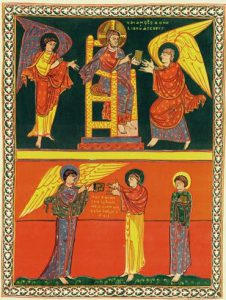 Pergamum as Satan’s Throne and Dwelling Place (Rev. 2:12)
Pergamum as Satan’s Throne and Dwelling Place (Rev. 2:12)
First-century Pergamum has two characteristics that might qualify her to be the place of Satan’s throne and his dwelling place. She has many temples associated with pagan deities, with temples to Zeus, Athena, and Asclepius being prominent among them. She also has a long history of emperor worship. Augustus approved Pergamum’s request to build a temple dedicated to him and to the goddess Roma (Rome) in 29 B.C. Pergamum’s second characteristic is a geographical one. She has an acropolis, that is, a citadel on a hill. In the first century, temples to Zeus and Athena were prominent features of her acropolis and they shared an altar for burnt offerings that was quite grand and highly visible. In the Old Testament, worship of the idols of false gods is often associated with mountains or hills. In Revelation, the Harlot, who entices the nations to worship the Beast, sits on seven hills; she is a city full of idolatry (17:9). Given these factors, Pergamum may be uniquely qualified for the label “throne of Satan” (2:13), but it is important to stress that she has competition among the cities of Asia Minor. The book of Revelation shows that worship of false gods and their idols was a major temptation for all of the seven churches. Various manifestations of the “throne of Satan” were everywhere in John’s day (2:13). Pergamum and Thyatira are not facing a unique temptation in comparison to the other churches, but they are the ones who are giving in to this temptation in order to fit into the pagan culture around them.
The Teaching of Balaam and Idolatry: An Instance of Typology
Revelation 2:14 says, “But I have a few things against you: you have there some who hold to the teaching of Balaam, who taught Balak to place a stumbling block before the sons of Israel so that they eat food sacrificed to idols and play the harlot.” Notice that Jesus is interpreting an Old Testament story in a typological manner. Balak, King of Moab, wants to stop the progress of the Israelites. He hires Balaam to curse Israel, but God makes sure that Balaam blesses Israel instead. However, Balaam instructs the king of Moab to entice Israel to worship Baal, which will alienate them from God (Num. 31:16). The enticing takes place when some Israelites become interested in some “women of Moab” (25:1). Some Israelites “play the harlot” or “commit sexual immorality” with them (Num. 25:1). Numbers 25:1-5 clarifies that the verb “play the harlot” (Hebrew: zanah) has a double sense. It refers to both physical sexual immorality with Moabite women and to worshiping idols with them, which is spiritual harlotry. According to Numbers 25:2, Israelites “play the harlot” with the women of Moab in the spiritual sense, because they go with them to make sacrifices to pagan gods, to eat sacrificial meals, and to bow down to pagan gods. When Israel does this, she is acting in clear violation of the first two of the Ten Commandments (Exod. 20:3-5) and she experiences the wrath of God, which involves death due to a plague (Num. 25:3-13). It appears, then, that Numbers 25:1-2 and 31:16 provides the type or pattern for what Jesus sees in the church of Pergamum.
The type or pattern is quite helpful for interpreting Revelation 2:14. Some Christians in the church of Pergamum are holding to the teaching of Balaam (Num. 31:16). This means that they are encouraging their fellow Christians that it is permissible to eat food sacrificed to idols and to worship the pagan gods (to “play the harlot” in the spiritual sense). Unlike Balaam, they are not intentionally trying to turn the people of God away from following him. They have become convinced that they are teaching what is right and good for Christians. Yet, the Old Testament, including the Ten Commandments, shows just how wrong they are. Numbers 25 is just one of many Old Testament stories that show the danger of combining worship of God with worship of other gods. In both Numbers 25:1-2 and Revelation 2:14, some of the people of God are “playing the harlot” (Greek: porneuo). In both places, the language of sexual immorality has to do with unfaithfulness to God involving worship of other gods (idolatry). Unlike Numbers 25:1-2, the primary emphasis of Revelation 2:14 is upon worshiping idols, rather than upon fornication or adultery. The evidence for this claim is the combination of the teaching of Balaam and food sacrificed to idols in Revelation 2:14. Both have to do with idolatry. In addition, the major vice of the book of Revelation is idolatry, which is always a form of worshiping the Beast and Satan (Rev. 13:4, 8, 17; 9:20-21; 21:8; 22:15). Everyone who does not worship God is worshiping the Beast (13:8). The False Prophet is busy enticing people to worship the Beast and kills those who will not do so (13:11-18). In the church of Thyatira, Jezebel is teaching the same heresy as the one at Pergamum (2:20). The language of the Thyatira letter will also support the claim that idolatry is the major sin that Christians at Pergamum are struggling with. Christ warns that judgment is coming for those who are holding to the teaching of Balaam (2:16). Revelation 2:15 appears to provide the name for this heretical group, that is, the Nicolaitans.
Suggested Resource: Find out about my free Bible study guide to the seven letters by clicking here.
Sources:
These paragraphs are from my book:
Paul Hoskins, The Book of Revelation: A Theological and Exegetical Commentary, pp. 84-85, 86-88 (those pages provide further sources and footnotes that I have omitted above).
